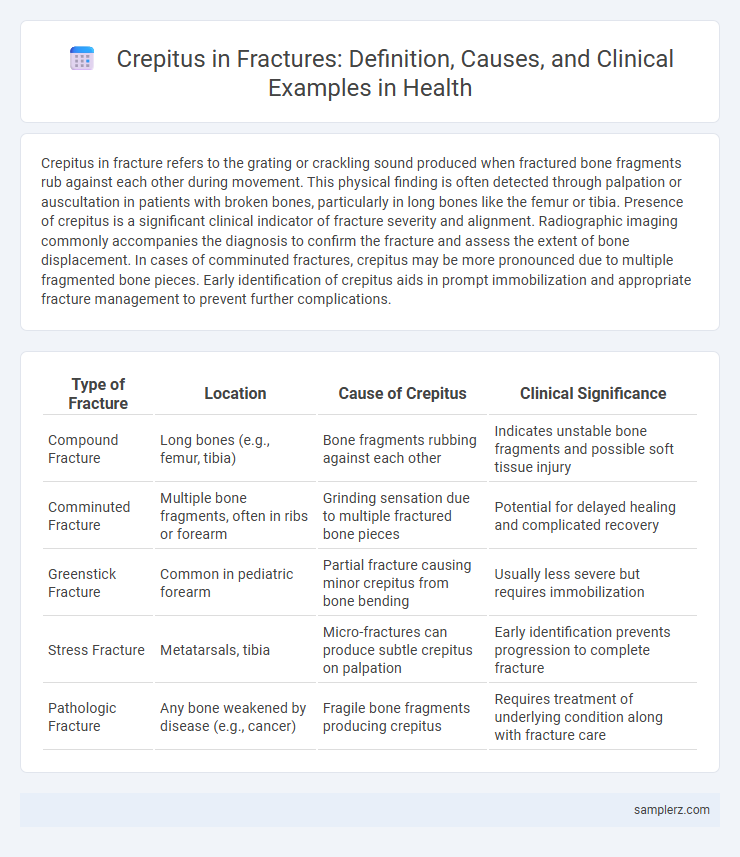Crepitus in fracture refers to the grating or crackling sound produced when fractured bone fragments rub against each other during movement. This physical finding is often detected through palpation or auscultation in patients with broken bones, particularly in long bones like the femur or tibia. Presence of crepitus is a significant clinical indicator of fracture severity and alignment. Radiographic imaging commonly accompanies the diagnosis to confirm the fracture and assess the extent of bone displacement. In cases of comminuted fractures, crepitus may be more pronounced due to multiple fragmented bone pieces. Early identification of crepitus aids in prompt immobilization and appropriate fracture management to prevent further complications.
Table of Comparison
| Type of Fracture | Location | Cause of Crepitus | Clinical Significance |
|---|---|---|---|
| Compound Fracture | Long bones (e.g., femur, tibia) | Bone fragments rubbing against each other | Indicates unstable bone fragments and possible soft tissue injury |
| Comminuted Fracture | Multiple bone fragments, often in ribs or forearm | Grinding sensation due to multiple fractured bone pieces | Potential for delayed healing and complicated recovery |
| Greenstick Fracture | Common in pediatric forearm | Partial fracture causing minor crepitus from bone bending | Usually less severe but requires immobilization |
| Stress Fracture | Metatarsals, tibia | Micro-fractures can produce subtle crepitus on palpation | Early identification prevents progression to complete fracture |
| Pathologic Fracture | Any bone weakened by disease (e.g., cancer) | Fragile bone fragments producing crepitus | Requires treatment of underlying condition along with fracture care |
Understanding Crepitus: Definition and Relevance in Fractures
Crepitus in fractures refers to the grating, crackling, or popping sensation or sound caused by the friction between broken bone fragments during movement. This physical sign is crucial for clinicians to assess fracture stability and alignment, often detected through palpation or auscultation during examination. Identifying crepitus aids in diagnosing specific fracture types and determining appropriate treatment plans to prevent complications like nonunion or malunion.
Common Types of Fracture-Related Crepitus
Crepitus in fractures commonly manifests as a grating or popping sensation caused by bone fragments rubbing together, frequently observed in displaced or comminuted fractures. Tibial shaft fractures and distal radius fractures are typical examples where crepitus is prominent due to irregular bone ends moving during palpation or limb movement. Identifying crepitus assists clinicians in diagnosing fracture severity and planning appropriate immobilization or surgical intervention.
How Crepitus Presents in Bone Fractures
Crepitus in bone fractures presents as a distinct grating or crackling sensation felt or heard when the fractured bone ends rub against each other during movement or palpation. This clinical sign often indicates the presence of bone fragments and is palpable through the skin over the fracture site. Diagnosing crepitus helps confirm the location and severity of the fracture, guiding appropriate medical intervention.
Clinical Signs: Detecting Crepitus During Fracture Assessment
Crepitus in fracture assessment presents as a palpable or audible grating sensation caused by bone fragments rubbing against each other. Clinicians detect crepitus through careful palpation and manipulation of the injured area, often correlating with swelling, deformity, and localized pain. Identifying crepitus aids in confirming fracture diagnosis and evaluating fracture stability during physical examination.
Locations Where Crepitus is Frequently Found in Fractures
Crepitus commonly occurs in fractures of long bones such as the femur, tibia, and humerus, where bone fragments rub against each other. It is also frequently detected in rib fractures, producing a characteristic grating sound during respiration. The wrist and ankle are additional sites prone to crepitus due to complex joint movements and frequent trauma.
Distinguishing Fracture Crepitus from Other Causes
Crepitus in fractures is characterized by a distinct grating or crunching sensation felt when broken bone fragments rub against each other during movement. This can be distinguished from other causes of crepitus, such as joint crepitus from cartilage wear or subcutaneous emphysema, by its localized tenderness, swelling, and deformity at the fracture site. Clinical examination combined with imaging studies like X-rays confirm bone discontinuity, ensuring accurate diagnosis and differentiation from soft tissue or joint-related crepitus.
Diagnostic Techniques for Identifying Crepitus in Fracture Cases
Crepitus in fracture cases is commonly identified through physical examination by palpating the affected area to detect crackling or grating sensations. Imaging techniques such as X-rays and computed tomography (CT) scans provide detailed visualization of bone fragments, confirming the presence of crepitus associated with fractures. Ultrasound can also be utilized to assess soft tissue involvement and detect abnormal air or fluid accumulations contributing to crepitus.
Implications of Crepitus for Fracture Severity and Management
Crepitus in fractures, characterized by a grating or cracking sound during movement, often indicates bone fragments rubbing together, signaling complex or unstable breaks. The presence of crepitus typically correlates with greater fracture severity, necessitating meticulous assessment through imaging techniques such as X-rays or CT scans. Effective management strategies, including surgical intervention and immobilization, are tailored based on the extent of the crepitus and the underlying bone displacement.
Example Case Studies Demonstrating Crepitus in Fractures
Case studies reveal crepitus as a common clinical sign in long bone fractures, such as tibial shaft fractures, where palpable grating corresponds to bone fragment movement. In humeral fractures, crepitus often indicates displacement and instability, guiding orthopedic intervention decisions. Detailed imaging combined with physical examination highlighting crepitus assists in accurate fracture classification and treatment planning.
When to Seek Medical Attention for Crepitus After Injury
Crepitus in fractures often presents as a grinding or popping sensation when broken bone fragments rub together, signaling possible complications such as bone misalignment or infection. Immediate medical attention is critical if crepitus is accompanied by severe pain, swelling, deformity, or numbness, as these symptoms indicate potential nerve damage or compromised blood flow. Early intervention by an orthopedic specialist can prevent long-term disability and ensure proper fracture healing.

example of crepitus in fracture Infographic
 samplerz.com
samplerz.com